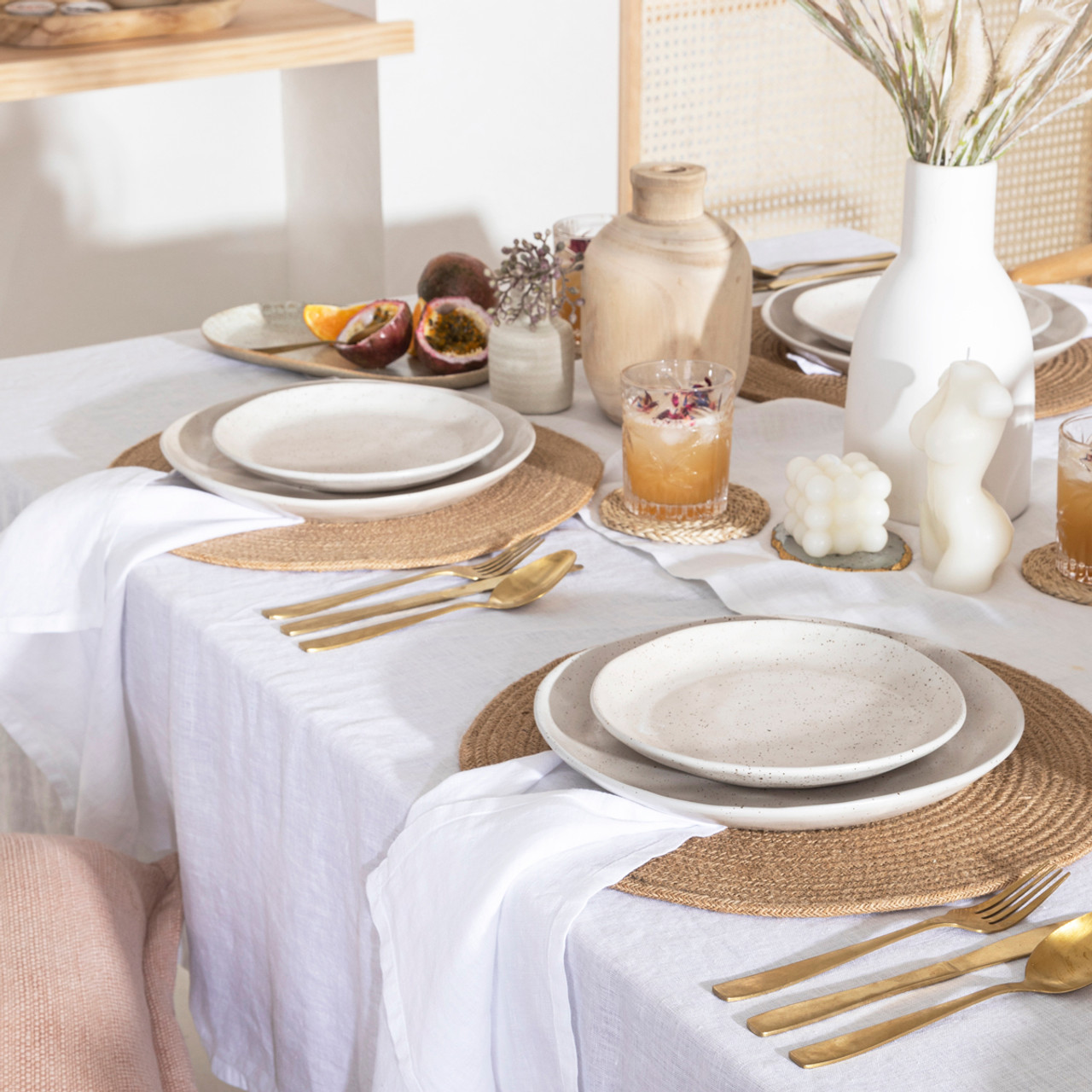Stylish Table Runner Ideas: Change Your Dining Experience
Wiki Article
Bed Linen Material Innovations: Checking Out Modern Trends and Creative Applications in Design and Textile Sector
From lasting manufacturing techniques to advanced weaving modern technologies, the development of linen is improving the landscape of the textile sector. As we dive into the worlds of imaginative style applications and the emergence of linen blends and crossbreed materials, a new chapter unfolds in which bed linen's function in future fabric developments takes center phase.Lasting Practices in Bed Linen Manufacturing
Lasting methods in bed linen manufacturing have actually come to be increasingly vital in the fabric sector's efforts to decrease environmental effect and advertise moral sourcing methods. Linen, an all-natural fiber derived from the flax plant, offers a variety of benefits such as durability, biodegradability, and breathability. Nonetheless, conventional approaches of bed linen production can involve significant water consumption, chemical use, and energy-intensive procedures.To address these difficulties, many fabric manufacturers are embracing lasting techniques throughout the linen production procedure. This consists of sourcing flax from organic farms that prevent harmful pesticides and chemicals, carrying out water-efficient retting strategies to extract fibers from the flax stalks, and utilizing green dyes and coatings. Additionally, some business are spending in renewable power resources to power their production facilities and reducing waste through recycling and upcycling efforts.
Technical Innovations in Bed Linen Weaving
With the expanding focus on lasting techniques in linen production, the fabric sector is currently observing a rise in technical innovations especially targeted at changing the art of bed linen weaving. These technologies are reshaping the method linen materials are generated, offering enhanced effectiveness, high quality, and creative thinking in weaving strategies.Among the essential technical innovations in bed linen weaving is the assimilation of digital looms. These innovative looms are outfitted with software program that enables intricate and complex styles to be woven with precision. By digitizing the weaving process, makers can attain higher uniformity and accuracy in their linen fabrics.
Additionally, improvements in yarn spinning modern technology have actually made it possible for the production of finer and more long lasting bed linen threads - table cloths. This causes softer and smoother linen materials that maintain their high quality also after several usages and laundries
Furthermore, the advancement of eco-friendly dyeing procedures and surfaces for linen materials is gaining traction. These lasting practices not only minimize the ecological impact but also deal with the increasing customer need for morally produced fabrics.
Creative Style Applications for Linen
Ingenious artistic methods are increasingly forming the innovative design applications for bed linen in the fabric sector. Bed linen's all-natural aesthetic charm and capability to mix with various other fabrics make it a favorite option for producing distinct garments and devices that provide to the ecologically conscious customer.In addition, designers are trying out linen in home design, utilizing its breathable and long lasting nature to craft stylish furnishings such as drapes, bed linen, and furniture. The structure and drape of bed linen bring a feeling of elegance and convenience to interior rooms, including a touch of sophistication to modern-day homes.

Bed Linen Blends and Crossbreed Fabrics

Hybrid materials, on the other hand, take the concept of blending an action better by integrating extra aspects such as metal strings, recycled products, or conductive fibers. These cutting-edge textiles not only broaden the design possibilities but additionally introduce practical aspects like conductivity, antimicrobial residential properties, or boosted durability. Crossbreed textiles are progressively being made use of in numerous industries, including style, interior decoration, and technological textiles, where the need for multifunctional products gets on the rise.
Linen's Function in Future Textile Innovations

In the realm of future fabric innovations, bed linen is anticipated to be a principal in the growth of sophisticated practical textiles. Developers and scientists are checking out means to improve linen's inherent qualities through technical improvements, such as integrating clever textiles, nanotechnology, and efficiency surfaces. These advancements aim to raise bed linen's performance qualities, making it ideal for a wider variety of applications, from activewear to protective garments.
Furthermore, the combination of bed linen with various other natural or artificial fibers opens limitless possibilities for developing novel textiles with special residential or commercial properties and capabilities. By leveraging linen's qualities and discovering cutting-edge blends, the textile industry is poised to introduce interesting advancements that satisfy developing consumer needs and sustainability needs.
Final Thought
Finally, the exploration of sustainable techniques, technical innovations, innovative style applications, linen blends, and its function in future fabric advancements highlight the constant evolution of bed linen textile in the contemporary layout and textile market. With a concentrate on advancement and creative thinking, the adaptability and eco-friendly nature of bed linen make it a beneficial product for suppliers and designers alike, leading the method for more growths and improvements in the area of textiles.As we delve right into the worlds of imaginative design applications and the introduction of bed linen blends and crossbreed materials, a new chapter unravels in which bed linen's function in future fabric technologies takes facility stage.
Discovering the blend of bed linen with flat sheet other fabrics has led to the introduction of innovative blends and crossbreed textiles in the modern textile market. Bed linen blends provide a distinct combination of the qualities of bed linen with those of various other fibers, resulting in fabrics that possess enhanced properties such as enhanced sturdiness, boosted draping, and decreased wrinkling.The development of bed linen blends and hybrid materials has established the stage for Linen to play a pivotal function in driving future textile technologies.In the world of future fabric developments, bed linen is expected to be an essential player in the advancement of advanced useful materials.
Report this wiki page